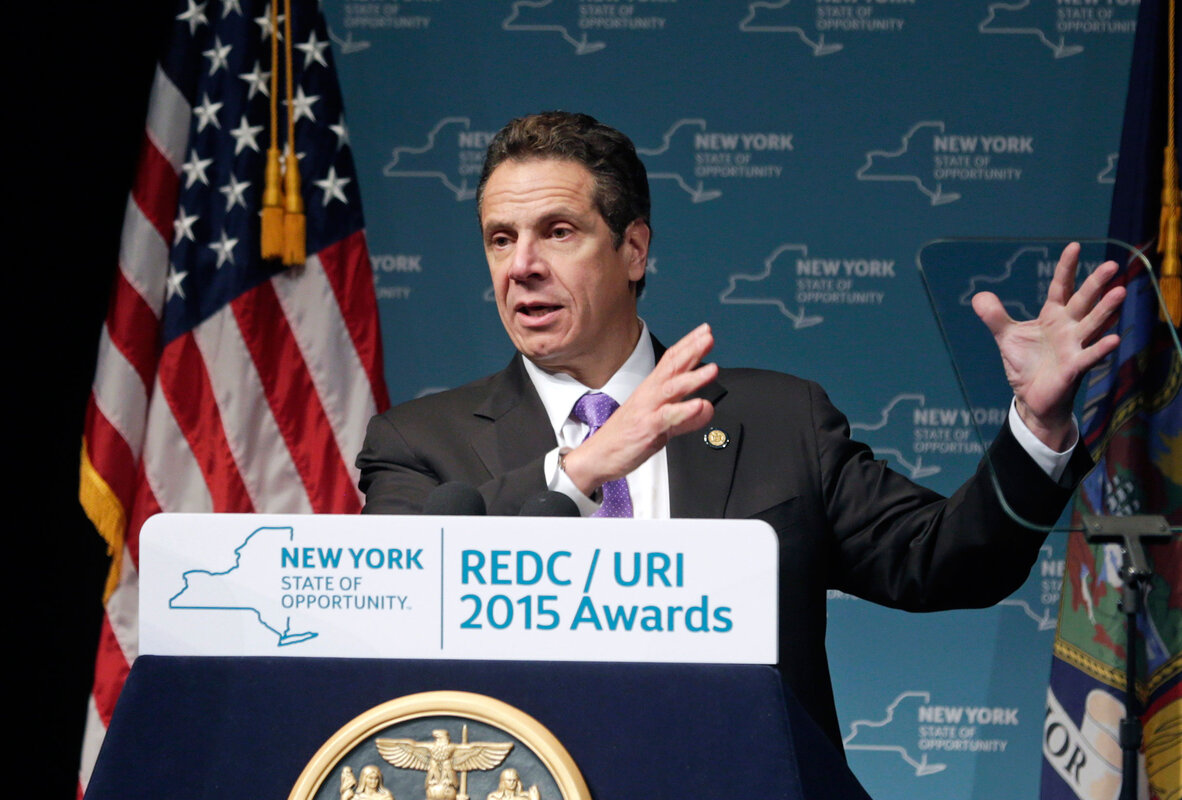Should prisoners get a free college degree? Why opinions are shifting.
Loading...
| New York
When New York Gov. Andrew Cuomo told a Harlem church this past Sunday that he wanted to once again try to provide college classes for New York state prisoners, he told the mostly black and Latino congregation in front of him that something had been lost in the nation’s criminal justice system.
“Prisons were not supposed to be a warehouse,” Governor Cuomo, a Democrat, told those at a service at Mount Neboh Baptist Church. “It was not supposed to be, ‘We’re going to take you and put you in a warehouse for 10 years and lock you up, and then take you out in 10 years and return you to society and think maybe you’re going to be the better for it.'"
“It was supposed to be about rehabilitation. It was supposed to be an opportunity to help people,” he continued. “We lost that somewhere along the way.”
Two years ago, Cuomo’s plan to provide $1 million to launch publicly-funded college programs in 10 state prisons – a blip in the state’s nearly $3 billion corrections budget – after many Republican lawmakers objected on principle: Why should prisoners get a free education when many law-abiding families struggle to pay to send members to college?
But an increasing body of research shows educating prisoners leads to significant long-term savings for the taxpayer, bolstering a growing nationwide, bipartisan movement now reassessing the social benefits of prison college programs. With nearly a half million prisoners being released from United States facilities and back into society each year, lawmakers have had rehabilitation back on their radar. And offering college courses, like the one Cuomo is trying to reboot in New York this week, are a prime example.
“Definitely I think there is a movement to reconsider what is being done within correctional facilities and to expand the opportunity for rehabilitation through college-level education,” says John Dowdell, co-editor of The Journal of Correctional Education and director of the Gill Center for Business and Economic Education at Ashland University in Ohio.
Such programs were once common, but after the Violent Crime Control and Law Enforcement Act, signed by President Bill Clinton in 1994, eliminated Pell Grants for anyone in state or federal prisons. In that era of crime-fighting fervor, the idea that tax dollars would provide a free college education for some inmates stuck many as unfair – even if they were effective.
“This meant a huge reduction of such programs overnight,” says Fred Patrick, director of the Center on Sentencing and Corrections at the in New York, which now runs new college education programs in 14 prisons in Michigan, New Jersey, and North Carolina. They partner with a number of local universities who give inmates transferable college credits for a course completed.
“Most now want individuals to return home prepared to get meaningful employment so they can take care of themselves and their families – to be law abiding, tax-paying citizens,” Mr. Patrick continues.
Part of the reason to revive such programs is that many lawmakers have been feeling the fiscal crunch of paying for the nation’s ever-burgeoning prisons. With 2.3 million inmates in its jails and prisons, the US incarcerates people at than any other developed country in the world.
And as Cuomo’s announcement at a black church in Harlem attests, many have also seen the need to address the disproportionate impact that mass incarceration has had on minority communities – and the many social barriers that those released from prison face upon reentry.
Last July, an executive action by the Obama administration created a new. It was a waiver from existing law to help states experiment with efforts “to create a fairer, more effective criminal justice system, reduce recidivism, and combat the impact of mass incarceration on communities,” the administration said.
And in November, California officials announced in an effort “to support higher education institutions in their efforts to provide opportunities to incarcerated and formerly incarcerated students.”
Cuomo finds another way
Unlike Cuomo's Republican-thwarted attempt two years ago to draw on the public purse for prison college education programs, his renewed push would be an executive maneuver.
He said that the new effort would be funded by $7.5 million in criminal forfeiture funds from the Manhattan district attorney – who has amassed from Wall Street fines and civil cases. Private foundations will provide $7.5 million more.
“In the context of criminal justice reform, there’s been, I think, a sea change in the way people are thinking about access to these kinds of programs,” says Douglas Wood, a program officer at the Ford Foundation, which has been supporting prison college programs across the country for the past few years.
Along with the Bill and Melinda Gates Foundation and others, Ford has helped underwrite programs such as the one at the Vera Institute, and will help New York state launch its program in conjunction with the State University of New York.
And Mr. Wood notes how much research has been done in the past few years, showing how much such programs both reduce recidivism – saving taxpayers millions – and improve the conditions of prisons.
According to a , inmates who participated in education programs – including remedial, vocational and college-level education – were 43 percent less likely to return to prison within three years.
“It’s a heck of an investment,” says Patrick at the Vera Institute. “For every dollar invested in prison education, there’s a $5 saving in reduced reincarceration costs,” he says, citing the RAND study. The institute’s is now in the second year of a five-year, $10 million initiative to provide inmates degree-track programs and other support after their release.
Two years ago, critics derided the place to offer college classes to New York inmates, calling it “Attica University” and using the slogan
On Sunday, however, Cuomo told the congregation in Harlem, “It’s wrong to put people in cages and waste young lives.”





